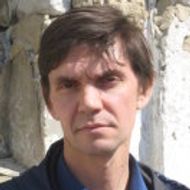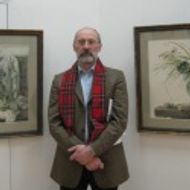- A
- A
- A
- ABC
- ABC
- ABC
- А
- А
- А
- А
- А
- HSE Campus in St. Petersburg
- School of Arts and Humanities
- Department of History
- News
- Buddhism in the Soviet transnational projects 1920 - 1980-ies
-
Department
-
Educational programmes
Address:
190068 Saint Petersburg
123 Griboedov channel, Room 123
Phone:+7 (812)786-92-49
Postal address:
190068 Saint Petersburg
123 Griboedov channel
The Department of History was created in 2012. The overarching goal of the department is systematic development of the field of global, comparative, and transnational history as a potent tool of overcoming the limitations of national history canon, fostering interdisciplinary dialogue in the field of social sciences and humanities, and brining new public relevance to historical knowledge. The department mission includes the development of new type of historical undergraduate and graduate education in Russia and pioneering new research fields in Russian historiography in dialogue with the global historical profession.
 Remembering the Neoliberal Turn: Economic Change and Collective Memory in Eastern Europe after 1989
Remembering the Neoliberal Turn: Economic Change and Collective Memory in Eastern Europe after 1989
Gökarıksel S., Gontarska O., Hilmar T. et al.
L.: Routledge, 2023.
Kritika: Explorations in Russian and Eurasian History. 2024. Vol. 25. No. 3. P. 644-658.
In bk.: Sweden, Russia, and the 1617 Peace of Stolbovo. Vol. 14. Turnhout: Brepols Publishers, 2024. P. 99-118.
Khvalkov E., Levin F., Кузнецова А. Д.
Working Papers of Humanities. WP. Издательский дом НИУ ВШЭ, 2021

Buddhism in the Soviet transnational projects 1920 - 1980-ies
His report was about complex relationships between the soviet government and Buddhism in Russia. Since the beginning of the 18th century Buddhism was an important part of the foreign policy of the Russian Empire, being as a connecting element with the Qing Empire. Despite the fact that in 1741 Buddhism was accepted by Executive Order of the Empress, a number of restrictions were imposed: for example, the amount of Datsans and Lamas was fixed. Despite these restrictive measures, the number of believers rapidly grew. At the end of the 19th century there were transnational projects about the inclusion of Buddhism in foreign policy, the aim of which was spreading of Russian influence in Mongolia and Tibet. In this process the active role played Aghvan Dorzhiev, who was a partner in the debates with the Dalai Lama XIII in the late 19th and early 20th century. It is important that in this situation Aghvan Dorzhiev was as an ambassador of a foreign country not Buddhism. He also continued to perform his functions in 1920th, despite the socio-political changes. Thus, in the Soviet policy took part the same Buddhist figures who participated in the creation of the imperial project about expansion their influence in Mongolia and Tibet. They tried to apply their ideas to the new material by offering project about Buryat autonomy and acting as advocates of reform of Buddhism, which was perfectly appropriate for Soviet transformation. The proposed project of the autonomy on the territory of the Soviet Union intended to respect the rights of minorities, showing a kind of a model of decolonization, which in the future could be spread to Asia. In this context Buddhism was a perfect ally of the Soviet power because of the atheistic spirit of its classical version. But since 1924, when was signed the agreement with China, the Soviet authorities waived the formal support of Buddhism. Since 1929 began the forced secularization, by the end of 1930th almost all believers were persecuted and soon all Buddhist monasteries were closed.
It is important that one of Buddhism’s functions in the Soviet transnational project was the accumulation of knowledge, which was connected with the desire of the Soviet elite to transform the Soviet Union into the apologist of enlightenment. In this context Tibetan medicine was especially significant, because in the 1920s Buryatia became a center of it. The problem was that the knowledge of Tibetan medicine accumulated in Datsans, that is why in 1920, the People's Commissar of Public Health Semashko advocated separation of Tibetan medicine from Buddhism. But in connection with the anti-religious policy of 1930-1940th can be seen a significant decline in this sphere. Nevertheless, in 1944 was revised the attitude to religion in general. After the liberation of Buddhist clergy from camps they made a campaign to raise funds for the army, for which they received a personal thanks from Stalin. Since 1945, can be seen a new attitude to Buddhism: Datsan of Hambo Lama was opened, and in 1946 was established the Centre for Spiritual Administration of the Buddhists. Soon they started to try resurrection of the transnational project of export the revolution and improving the image of the Soviet Union in Asia. Since 1950, Soviet Union received delegations of Buddhists and sent their own one in Asia. So, in 1979 Soviet authorities invited the Dalai Lama three times. However, such activity was hidden from the Buryat-Mongolian public. There was no mention about it in media, but it was possible to find texts defaming Tibetan medicine. Within the country, there were only two Datsan, and the faithful had no opportunity to open new one. But despite these limitations, there was the movement that led to the spread of Buddhism beyond Buryatia, Kalmykia and Tuva in Leningrad, Latvia and Estonia, which created its own Buddhist centers. However, the project to use Buddhism to transform the Soviet Union into a global center of the Enlightenment could not be realized.
Report of Jeanne Kormina was dedicated to "Reception of the religious policy of the postwar period: the conflict of interpretations (Pskov region)." She worked with documents of the postwar period, in which can be considered religious life. She used the reports of the Ombudsman of a church or religious cults, Alexandr Ivanovich Luzin. To begin with, Jeanne Kormina mentioned about specificity of the region, where after the war were 14 churches and monastery in the former Latvian and Estonian territories. There also existed 6 non-Orthodox Christian parishes. In addition, several priests during the war were convicted under the Article 58. Another important feature was the fact that the center of Orthodox life was far away, in Leningrad, and in the post-war conditions with the destruction of roads local religious authority played the main role. It is also significant that from the middle of the war the policy toward religion was radically changed. It was complicated for acceptance by the local religious communities, as well as Soviet functionaries, who recently took part in the anti-religious activity.
After the war Alexander Ivanovich Luzin had three roles. Firstly, he was a Soviet functionary, performs economic order of the executive committee. Secondly, he was an ethnographer, because Council for Russian Orthodox Church demanded from him reports and a detailed analysis of the situation. Third, he was religious researcher, because he had to decide for himself, which questions were about religion, because these questions were important for his work.
The presence of the church and the clergy irritated Soviet functionaries at all levels, because they created the non-controlling zone, which was not organized according to socialist laws. The reason for it was, for example, the practice of charity, because the basis of the church’s economy was a donation, what was fully against the principles of the planned economy of the Soviet Union. In addition, priests and church’s officials were not fit for the Soviet system of social stratification, that is why from 1946 until the mid-1980s, they were classified as “nekooperirovannye kustari”.
Jeanne Kormina mentioned about the conflict between the Soviet state and religious activists. It was connected with the fight over the time of the collective farmers or city residents. The problem was that calendars of the church and collective farm were not same. Farmers could decide not to work for the feast of the Ascension, agreeing to work on Sunday. Another such example is the decision to build a new club on the island Zalit during their free time rather than remake the Church for this purpose. Thus, the presence of the church showed that even in difficult post-war conditions there was an opportunity to make a choice and it could be not in favor of the state.
During the discussion, which was conducted by Nikolai Vladimirovich Ssorin-Chaikov, was raised the question about the plurality of religion and government, which can be very clearly seen in the case of Jeanne Kormina. Ivan Sablin also said about duality in the management of diversity. On the example of his case can be considered a complete failure of it, because despite the various restrictive measures, Buddhism was out of control of the Soviet authorities and spread far beyond boundaries of Buryatia. Furthermore, in this context it is important how the Soviet system could overcome national and cultural boundaries. Ivan Sablin claimed that Buddhism perfectly suited for the realization of such transnational and transcultural projects because of it’s inclusion. The participants also discussed the question about the boundary between the religious and the "Soviet". It was menioned that Buddhist lamas were also public servants with an official status. So, it was necessary to be a member of the Central Spiritual Directorate of Buddhists. Those who were not included in the system were a kind of religious dissidents.
Valentina Smirnova.
-
https://elearning.hse.ru/en/mooc/
Massive Open Online Courses
-
https://www.hse.ru/en/visual/
HSE Site for the Visually Impaired
-
http://5top100.com/
Russian Academic Excellence Project 5-100
- © HSE University 1993–2024 Contacts Copyright Privacy Policy Site Map
- Edit

